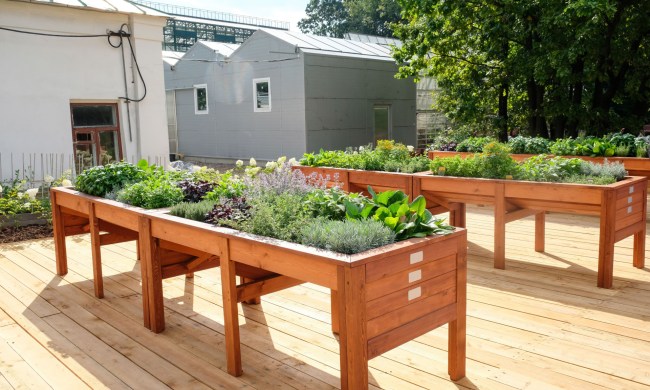We all have a friend, or we are that friend, who loves to garden. Whether it’s flowers, house plants, or vegetables, there’s a type of gardening for everyone. Luckily, there’s also a gardening book for everyone. Here are some of the best books to gift to the gardeners in your life, no matter what their pleasure is — indoor gardening, veggies, beautiful blooms, or something in between.
Raised Bed Gardening by Tammy Wylie
“Raised Bed Gardening for Beginners” by Tammy Wylie shows even the most inexperienced gardener how to turn a small space into a haven for vegetables. In her book, she walks through the process of planning, building, and filling a raised bed garden. There are sections about crop rotation, seed starting, and soil.
At the end of her book, the author highlights tips and tricks for specific plants. Here you’ll learn about spacing, watering, light, and the growing season. Even veteran gardeners can benefit from this easily digestible book about starting and sustaining a thriving raised bed garden.
The Vegetable Gardener’s Bible by Edward C. Smith
Filled to the brim with helpful diagrams and photos, Edward C. Smith’s book, “The Vegetable Gardener’s Bible,” is a book every gardener needs in their arsenal. If lots of space is available to you, Smith goes into detail about how you can grow a high-yield garden all on your own.
The author also suggests using wide rows, organic methods, raised beds, and deep soil. This is what he calls the W-O-R-D system, and he stands by the fact that any gardener within North America can use this and be successful. Check it out for yourself or a friend!
Field Guide to Urban Gardening by Kevin Espiritu
Not only did Kevin Espiritu write this incredible book about urban gardening, but he also runs two very successful YouTube channels, a blog, a Twitter, and an Instagram. While he’s busy with all these ventures, he still has time to grow and maintain his vast epic garden.
In his book, “Field Guide to Urban Gardening,” Espiritu teaches you that even within a high-rise apartment, there is something you can grow. Using containers, bags, or hydroponics, there is something that will work for everyone.
There are also in-depth gardening plants and upscale DIY projects to bring solutions to your growing problems and recycle items that would end up in a landfill. With this book, the author proves that everyone has a green thumb.
The Holistic Orchard by Michael Phillips
Fruit trees are one of the most intimidating types of gardening to old and new gardeners alike. However, with Michael Phillips’ book, “The Holistic Orchard,” everyone can learn to care for and grow productive fruit trees.
In his book, Phillips covers grafting, pruning, pollination and teaches you how to deal with bugs, disease, and pests.
Take on the challenge and help the planet while you’re at it by planting fruit trees that produce not only delicious fruit but also provide excellent habitats and ecosystems for pollinators and other beneficial animals.
Mini Farming: Self-Sufficiency on 1/4 Acre by Brett L. Markham
More and more people are gaining interest in becoming self-sustaining. You probably know someone who talks about it or is even attempting it. This book would be an excellent gift for those looking to be more responsible for their own food.
Brett L. Markham talks about a holistic approach to small-area farming. In his book, “Mini Farming: Self-Sufficiency on 1/4 Acre,” he claims to be able to provide 85 percent of the average family’s food. Markham’s book teaches you everything you need to know from seed starting to crop rotation and dealing with pests and disease.
Floret Farm’s Cut Flower Garden by Erin Benzakein
While growing edible foods in your garden is delicious, growing beautiful flowers is just as fun and rewarding. In her book, “Floret Farm’s Cut Flower Garden,” Erin Benzakein teaches how to grow flowers in various climates. She also gives clear and precise instructions on cutting and arranging a wide range of flower arrangements. From garlands to centerpieces, you’re sure to learn everything you need to start a new hobby or hone an already established skill in flower arranging.
100 Plants to Feed the Bees by the Xerces Society
We can’t talk about gardening without talking about pollinators. Without these beautiful and vital insects, vegetable plants wouldn’t produce fruit, flowers would wilt and die, and the earth would be much less green and beautiful. In their book, “100 Plants to Feed the Bees,” the Xerces Society talks about important flowers, herbs, and trees to plant to support the delicate ecosystem of pollinators in your area.
Included within the book are plant profiles where you can learn about where the plant grows, which pollinator will benefit from it, and where and when to plant it within your landscape or garden. This book is an excellent addition to any gardener’s library and will complement any of the books mentioned above.
Gardening is one of the healthiest hobbies you can start. Not only is it great exercise, but it’s also great for our mental health. Whether your friends are gardening newbies or seasoned enthusiasts, one of these books is sure to make a great gift. Get outdoors and explore the exciting and rewarding gift of nature with these books as a guide.


